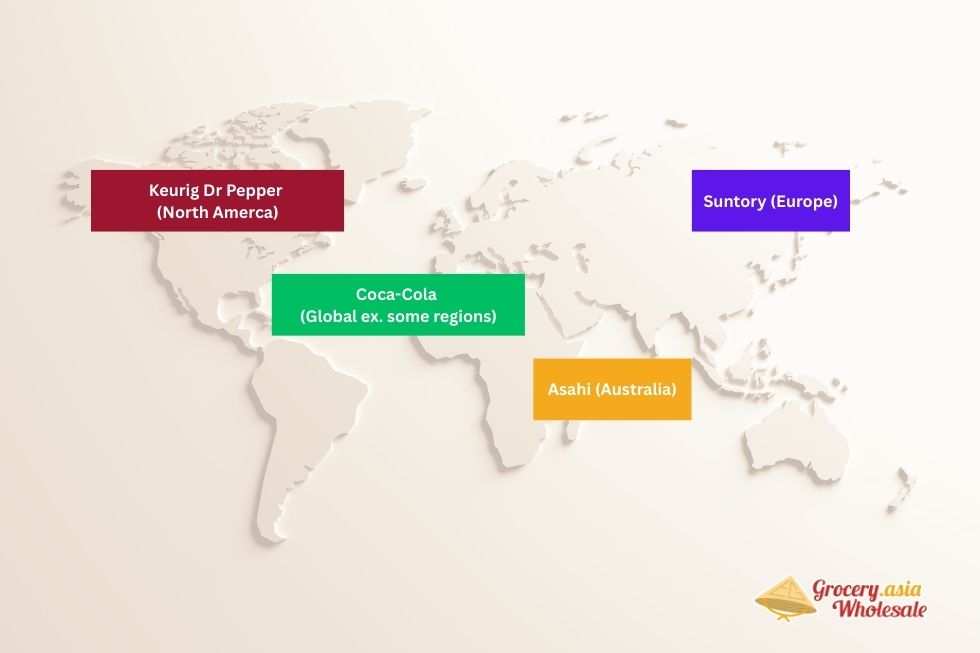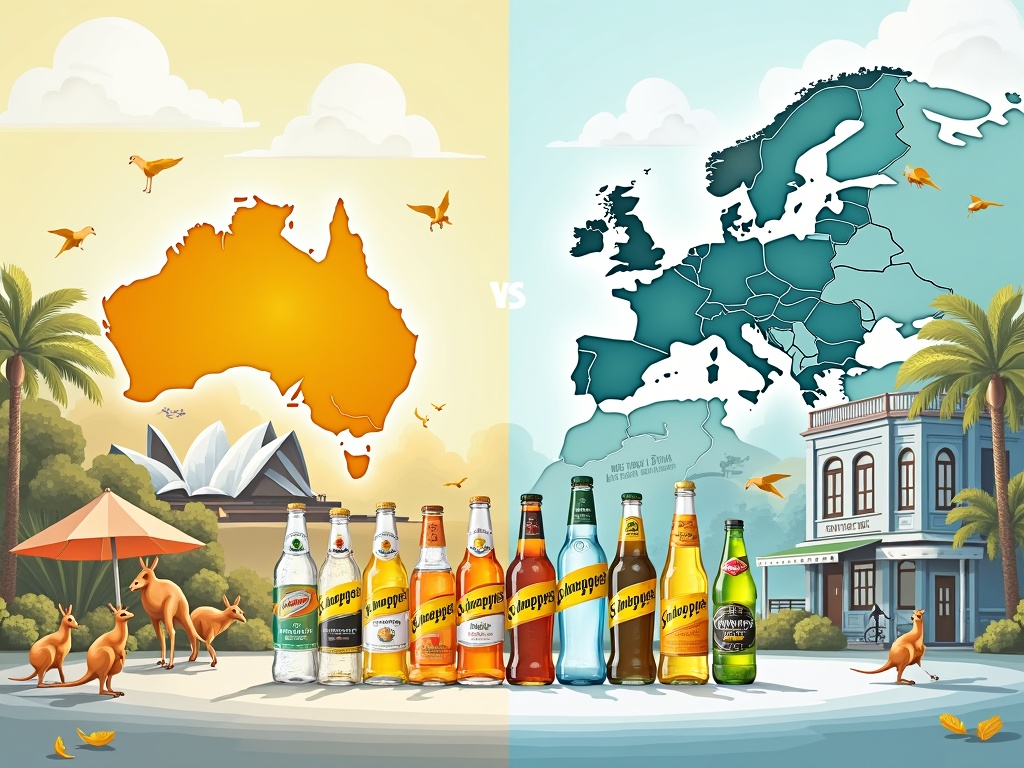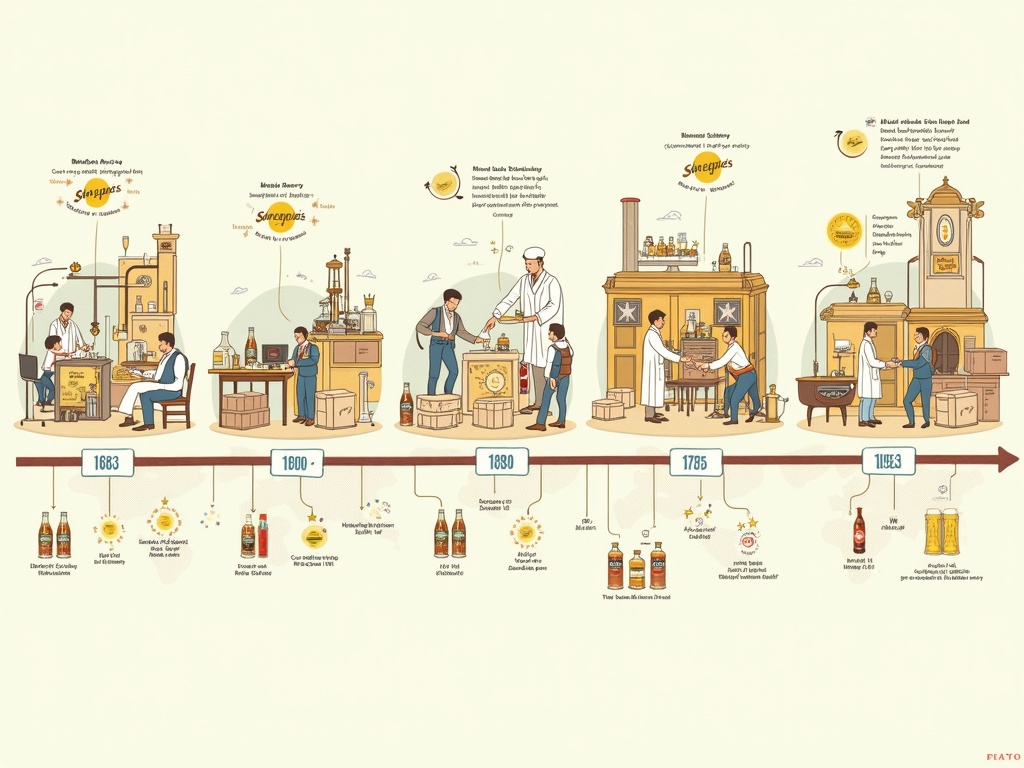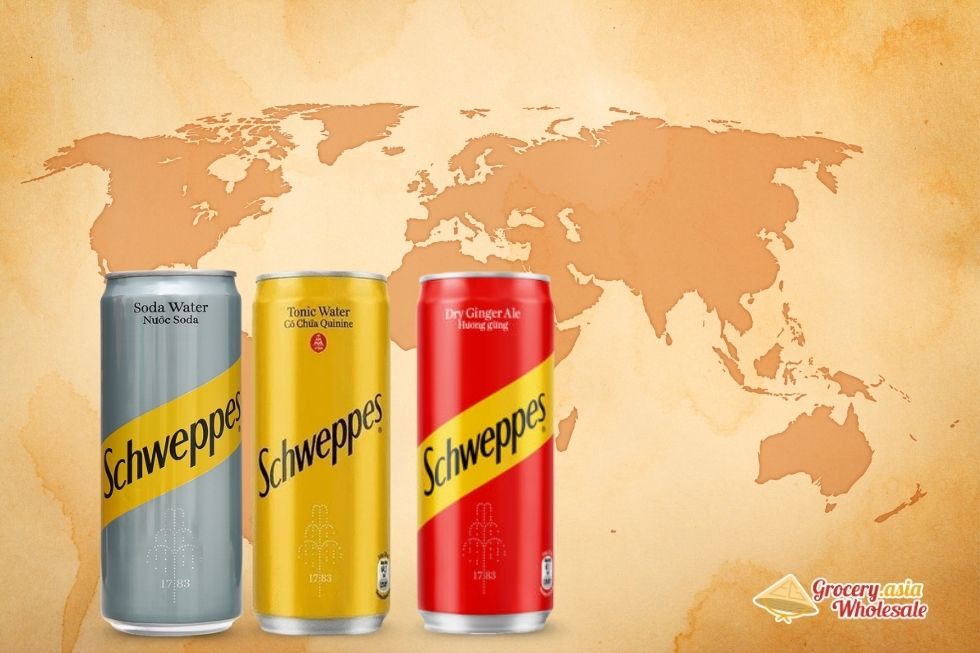No products in the cart.
Beverages News, Schweppes, Soft Drinks
Who Owns Schweppes The Company Behind The Drink
Schweppes operates under a unique, fragmented ownership structure worldwide, shaped by historical corporate maneuvers and regional market strategies. Following the 2008 demerger of Cadbury Schweppes plc, the brand became divided among several international beverage giants, resulting in distinct ownership and management of Schweppes products across global markets.
Table of Contents
Key Takeaways
- The Coca-Cola Company holds rights to the Schweppes brand in over 150 countries, including the UK, after a $1.85 billion acquisition in 1999. It manages manufacturing and distribution across these regions.
- Keurig Dr Pepper oversees Schweppes operations in North America (USA and Canada), having acquired the rights through a series of corporate mergers initiated after the 2008 demerger.
- Japanese companies control important regional markets with Asahi Group Holdings managing operations in Australia since 2009, and Suntory Group overseeing Schweppes in several European markets such as Spain, Portugal, and France.
- Product formulations vary significantly across countries due to the brand’s fractured ownership. These variations reflect adaptations to local taste preferences and comply with differing regulatory standards.
- The fragmented structure originated from the 2008 Cadbury Schweppes demerger, which separated beverage and confectionery segments. This split opened the door for strategic acquisitions by major beverage companies aiming for regional dominance.
For more details on the historical evolution of the Schweppes brand, the official Coca-Cola Company website offers insights into its global brand portfolio and the brand’s regional presence.
The Complex Web of Schweppes’ Global Ownership
The answer to who owns Schweppes isn’t straightforward – ownership of this iconic brand has been divided among several major beverage corporations across different geographic regions. This fragmented structure means that depending on where you purchase your Schweppes tonic water, you’re actually buying from entirely different parent companies.
Regional Ownership Breakdown
I can break down the current ownership structure by examining each major region and its respective corporate owner:
- North America (USA & Canada): Keurig Dr Pepper holds the rights to manufacture and distribute Schweppes products throughout these markets
- United Kingdom & various other nations: The Coca-Cola Company controls the brand in these territories
- Australia: Asahi Group Holdings owns and operates the Schweppes brand
- Much of Western Europe (including Spain and France): Suntory Group manages distribution and production
This geographic division creates a unique situation where the same brand operates under completely different corporate umbrellas depending on your location. Each regional owner maintains control over production, marketing, and distribution within their designated territories.
Historical Context Behind the Fragmentation
The current ownership structure stems from the significant corporate restructuring that occurred in 2008. The original Cadbury Schweppes plc underwent a major demerger that year, which fundamentally changed how the Schweppes brand would be owned and operated globally.
Prior to this pivotal moment, Cadbury Schweppes operated as a unified entity controlling both confectionery and beverage operations worldwide. The demerger split these operations, with Cadbury focusing on confectionery while the beverage assets, including Schweppes, were divided among various beverage companies based on regional considerations and strategic partnerships.
This fragmentation resulted from a series of complex mergers, acquisitions, and strategic decisions made over several decades. Each acquiring company brought different strengths to their respective regions:
- Keurig Dr Pepper‘s strong North American distribution network
- Coca-Cola‘s global beverage expertise
- Asahi‘s dominance in the Australian market
- Suntory‘s European presence
The divided ownership structure affects everything from product formulations to wholesale distribution strategies. Different regional owners may adjust recipes to suit local tastes, implement varying marketing campaigns, and establish distinct supply chain operations.
Understanding this ownership structure becomes particularly important for international businesses, retailers, and consumers who operate across multiple regions. The variation in ownership can impact everything from product specifications to availability and pricing structures.
Each regional owner maintains the Schweppes brand identity while adapting their operations to local market conditions and regulatory requirements. This approach allows the brand to maintain its global recognition while benefiting from each parent company’s regional expertise and established distribution networks.
The fragmented ownership model reflects broader trends in the global beverage industry, where regional specialization often proves more effective than centralized control. This structure enables each owner to leverage their specific market knowledge and operational capabilities while maintaining the consistent quality and brand recognition that consumers expect from Schweppes products worldwide.

Coca-Cola: The Brand’s Largest Global Owner
The Coca-Cola Company stands as Schweppes‘ primary owner across most international markets, controlling manufacturing and distribution rights in the United Kingdom and over 150 other countries worldwide. I can trace this ownership back to 1999 when Coca-Cola acquired these extensive rights from Cadbury Schweppes plc for approximately $1.85 billion, marking one of the beverage industry’s most significant acquisitions.
Distribution and Operations Structure
Coca-Cola’s ownership structure operates through strategic partnerships that ensure efficient market coverage. Coca-Cola Europacific Partners (CCEP) manages the critical bottling and distribution operations throughout Great Britain, creating a streamlined supply chain that reaches consumers across the region. This partnership model allows Coca-Cola to maintain quality control while leveraging specialized distribution expertise.
The brand’s prestige receives additional validation through its Royal Warrant status in the UK, granted in 1836. This historic designation signifies Schweppes’ position as an official supplier to the Royal Household, adding considerable brand value that Coca-Cola has carefully preserved throughout its ownership period.
Product Portfolio Under Coca-Cola Ownership
Under Coca-Cola’s stewardship, the UK Schweppes portfolio encompasses several distinctive products that reflect both traditional recipes and modern consumer preferences. The product lineup includes these key offerings:
- Schweppes Indian Tonic Water in various formulations including Slimline and Elderflower variants
- Bitter Lemon with its characteristic sharp citrus profile
- Traditional Lemonade maintaining classic flavor profiles
- Ginger Ale featuring the brand’s signature spice blend
- Russchian, a specialty beverage unique to certain markets
These UK products demonstrate significant differences from North American formulations, reflecting regional taste preferences and regulatory requirements. I’ve observed that Schweppes tonic water recipes vary considerably between markets, with the UK versions maintaining distinct characteristics that align with local consumer expectations.
Coca-Cola’s ownership has enabled consistent quality standards while preserving the authentic flavor profiles that built Schweppes’ reputation. The company’s extensive distribution network ensures product availability across diverse retail channels, from premium establishments to everyday grocery stores. This broad reach supports both wholesale operations and direct consumer sales.
The acquisition strategy proved financially sound for Coca-Cola, providing immediate access to established premium beverage categories and strengthening the company’s position in mixer and specialty drink markets. Schweppes’ heritage brand recognition, combined with Coca-Cola’s operational excellence, creates a powerful combination that continues driving market growth.
Product quality and shelf life management remain priorities under Coca-Cola’s ownership, ensuring consistent consumer experiences across all markets. The company’s investment in production facilities and quality control systems supports the premium positioning that Schweppes maintains in competitive beverage categories.
Coca-Cola’s ownership extends beyond simple manufacturing rights to encompass brand development, marketing strategies, and innovation initiatives that keep Schweppes relevant in changing consumer markets. This comprehensive approach has sustained the brand’s growth trajectory while honoring its historical legacy and maintaining the quality standards that consumers expect from this iconic beverage brand.
Keurig Dr Pepper: The North American Steward
I can trace Keurig Dr Pepper’s ownership of Schweppes back to a significant corporate transformation that began in 2008. When Cadbury Schweppes Americas Beverages underwent its spin-off, it became Dr Pepper Snapple Group, securing control of the Schweppes brand across the United States and Canada.
The story took another major turn in 2018 when Dr Pepper Snapple Group merged with Keurig Green Mountain in a massive $18.7 billion deal. This merger created Keurig Dr Pepper (KDP), positioning the company as one of North America’s largest beverage corporations. Through this acquisition, KDP gained stewardship over Schweppes’ North American operations, including manufacturing, distribution, and marketing rights.
Product Portfolio Under KDP Management
KDP markets several distinct Schweppes varieties specifically formulated for North American tastes:
- Schweppes Ginger Ale remains the flagship product, offering both regular and diet versions
- Schweppes Tonic Water maintains its premium positioning in the mixer category
- Schweppes Club Soda serves as a versatile carbonated water option
- Schweppes Sparkling Seltzer Water comes in multiple flavors, catering to growing consumer demand for flavored sparkling beverages
I’ve observed that these North American formulations differ substantially from international versions. KDP has adapted recipes to align with local preferences and regulatory requirements, creating products that taste distinct from their global counterparts. This regional customization reflects the company’s understanding of North American consumer preferences and market dynamics.
The merger with Keurig brought additional distribution capabilities and manufacturing efficiency to Schweppes operations. KDP’s extensive network allows Schweppes products to reach convenience stores, supermarkets, and restaurants throughout the United States and Canada. This infrastructure supports the brand’s continued growth in competitive beverage markets.
KDP’s ownership represents a significant chapter in Schweppes’ evolution, demonstrating how global trade strategy adapts to regional market needs. The company’s focus on innovation and market responsiveness has helped maintain Schweppes’ relevance in an increasingly crowded beverage landscape. Through strategic product development and targeted marketing, KDP continues to honor the brand’s heritage while adapting to contemporary consumer demands across North America.
Japanese Ownership: Suntory in Europe and Asahi in Australia
The global Schweppes brand operates under different Japanese owners across key international markets, creating a complex ownership structure that reflects strategic regional acquisitions over the past decade. I’ll explain how two major Japanese beverage companies have divided control of this iconic brand.
Asahi’s Australian Operations
Asahi Group Holdings controls Schweppes operations throughout Australia following a significant acquisition in 2009. The Japanese beverage giant purchased Schweppes Australia from Cadbury plc for A$1.185 billion (approximately US$810 million), securing one of the country’s most recognizable soft drink brands.
This acquisition package extended beyond Schweppes alone, incorporating other beloved Australian beverages including Solo and Cottee’s. Asahi’s investment demonstrated confidence in the Australian market’s growth potential and the enduring appeal of these local favorites.
Under Asahi’s ownership, Australian consumers can find several distinctive Schweppes products that reflect local taste preferences:
- Schweppes Traditional Lemonade – a classic Australian favorite
- Schweppes Agrum Blood Orange – offering a citrus twist
- Schweppes Indian Tonic Water – maintaining the tonic water legacy
- Schweppes Dry Ginger Ale – a staple mixer for the Australian market
Suntory’s European Portfolio
Across multiple European markets, Suntory Group manages Schweppes through its subsidiary Suntory Beverage & Food Europe (SBFE). This ownership arrangement stems from Suntory’s €2.6 billion acquisition of Orangina Schweppes Group in 2009, the same year Asahi secured the Australian operations.
Suntory’s European control spans several key markets including Spain, Portugal, and France. The acquisition brought Suntory a comprehensive beverage portfolio that includes not only Schweppes but also Orangina and Lucozade in certain regions.
This strategic purchase allowed Suntory to establish a strong European presence while maintaining the distinct character of each brand within its portfolio. The company has continued to invest in production facilities and distribution networks across these European markets, ensuring consistent product availability and quality standards.
The Japanese ownership model has proven successful for Schweppes in both regions, with each parent company bringing substantial resources and market expertise. Asahi’s focus on the Australian market has enabled targeted product development that resonates with local consumers, while Suntory’s European approach has maintained brand heritage while expanding market reach.
Both companies have demonstrated commitment to preserving Schweppes’ traditional formulations while adapting to regional preferences. This balance between maintaining brand authenticity and meeting local market demands has contributed to continued success under Japanese ownership.
The acquisition timing of both deals in 2009 reflects the strategic thinking of Japanese beverage companies during a period of global market consolidation. These investments have paid dividends, establishing both Asahi and Suntory as major players in their respective regional markets while ensuring Schweppes maintains its position as a premium mixer and soft drink brand.

From Swiss Innovation to Global Brand: The Schweppes Timeline
I trace the remarkable journey of Schweppes back to 1783, when Jacob Schweppe, a German-Swiss watchmaker and amateur scientist, perfected the process of carbonating water. This innovative breakthrough laid the foundation for what would become one of the world’s most recognizable beverage brands. Schweppe’s scientific approach to creating effervescent water represented a significant advancement in beverage production technology.
Early Foundation and Royal Recognition
Building on his carbonation success, Schweppe established his first factory in London in 1792, marking the brand’s transition from scientific experiment to commercial enterprise. The company’s commitment to quality and innovation earned it prestigious recognition when King William IV granted Schweppes a Royal Warrant in 1836. This royal endorsement solidified the brand’s reputation and opened doors to elite markets across the British Empire.
Corporate Evolution and Modern Ownership
The modern ownership structure of Schweppes began taking shape through strategic mergers and acquisitions. In 1969, Schweppes Limited merged with Cadbury Group to form Cadbury Schweppes plc, creating a powerful confectionery and beverage conglomerate. This partnership lasted for three decades before significant changes reshaped the company’s structure.
The most pivotal moment in Schweppes’ corporate history occurred in 1999 when Cadbury Schweppes sold beverage brands operating in over 150 countries to The Coca-Cola Company. This massive transaction transferred significant portions of the global Schweppes business to Coca-Cola’s portfolio.
Further corporate restructuring followed in 2008 when Cadbury Schweppes underwent demerger, spinning off its U.S. beverage unit into Dr Pepper Snapple Group (now known as Keurig Dr Pepper). The transformation continued in 2009 as the remaining beverage businesses expanded into new markets. Asahi acquired operations in Australia, while Suntory secured European territories.
These strategic corporate maneuvers created the current fragmented ownership structure that characterizes Schweppes today. Different regions operate under various parent companies, with global trade strategies varying by territory. The Coca-Cola Company maintains control over many international markets, while regional operators handle specific territories under licensing agreements.
This complex ownership pattern affects everything from wholesale distribution to product formulations across different markets. Understanding this corporate structure proves essential for businesses involved in international beverage trade, as export regulations and shelf life standards can vary significantly between regions.

Final Thoughts
The story of Schweppes is unlike any other in the beverage world. From its Swiss beginnings in 1783 to its current fragmented ownership across Coca-Cola, Keurig Dr Pepper, Asahi, and Suntory, Schweppes has continuously adapted through centuries of corporate transitions and regional strategies. This unique ownership model allows the brand to remain globally recognized while tailoring products to local markets — a balance that explains Schweppes’ enduring success.
For businesses, understanding this complex structure is more than just history; it’s about knowing where and how to source Schweppes products effectively. With different recipes, ownership, and distribution rights across regions, reliable sourcing partners are key to accessing authentic products and maintaining consistency for your customers.
Sources:
The Coca-Cola Company: “Coca-Cola: The Brand’s Largest Global Owner”
Keurig Dr Pepper: “Keurig Dr Pepper: The North American Steward”
Asahi Group Holdings: “Japanese Ownership: Suntory in Europe and Asahi in Australia”
Suntory Group: “Japanese Ownership: Suntory in Europe and Asahi in Australia”
Cadbury Schweppes plc: “From Swiss Innovation to Global Brand: The Schweppes Timeline”


